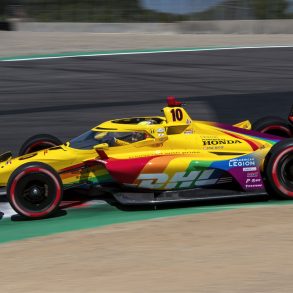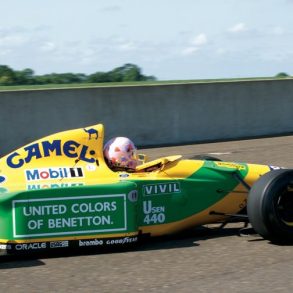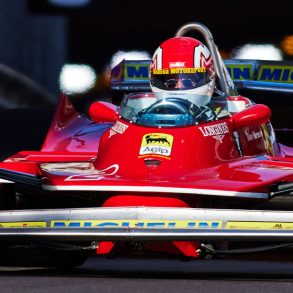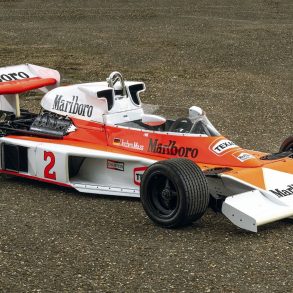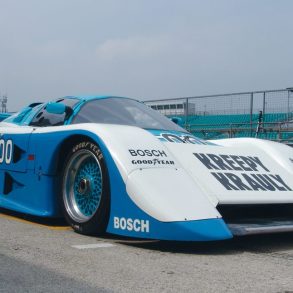Dan Gurney Biography
He drove in the last great era of Grand Prix racing before the advent of tobacco advertising and aerodynamic devices changed the sport forever. Is adversaries were some of the greatest names in Grand Prix history, Jack Brabham, John Surtees, Graham Hill and perhaps the greatest of them all Jimmy Clark. Each on a World Champion. Yet they considered him, this tall Californian, very much their equal.
Dan Gurney was born in New York, in 1931. In 1948 the family moved to Southern California. After a stint in Korea Gurney returned to Riverside California and took to racing hot-rods. Soon he graduated to sports cars and was offered the opportunity by a New York Ferrari dealer to race one of his cars at Le Mans. There he impressed the factory team ad was offered a chance to drive. This was 1959 and the young Californian was all of 28 years old. Racing only occasionally he went to BRM the following year. There he suffered a crash that resulted in the death of a spectator. This would color his entire year.

The story of Dan Gurney must also be the story of his famous Eagle racing cars. In 1962 he along with fellow American Carroll Shelby shared their dream of an American built racing car that could compete with the best cars of Europe. Gurney’s Formula 1 career was still in full swing and it wasn’t until 1964 that the initial steps were taken in establishing a team. During that same period American racing and its premier event Indianapolis, was ruled by Firestone Tires. Goodyear was looking for a way to challenge their domination. Shelby who had previous contact with the company convinced them to sponsor their new team. Up to that time the team had no official name and it was Goodyear’s president Victor Holt who suggested “All-American Racers”. Gurney, not wanting to appear too jingoistic was hesitant at first but deferred to their financial benefactor.
AAR’s initial focus was Indianapolis and Goodyear’s battle with Firestone but Dan Gurney had always loved road racing, especially in Europe. His dream as a driver had been to win the World Championship as Phil Hill had done in 1961. With his new team he hoped that it would come while driving an American Grand Prix Eagle. Since the main financial backing provided by Goodyear was intended for Indianapolis any budget for Formula One had to come from savings in that program. Ex-Lotus designer Len Terry now with AAR designed the 1966 Indy car with the idea of making them also suitable for road racing with moderate modifications. Unlike the other Indy cars the Eagles had symmetrical suspension and a smaller fuel capacity. For Grand Prix racing the cars would also be built with thinner skins saving at least 50 lbs. per car.
The Grand Prix effort was based in Rye on the south coast of England near the Weslake factory. Weslake would provide the engine to power the cars. Gurney had contacts with the Rye based company through people he had known back in his BRM days. Weslake had never built a complete engine for cars before; their experience had been with motorcycles but their design for a twelve-cylinder 3-liter engine looked promising. At that time all of the British teams save BRM were scrambling for new power plants due to the doubling in allowed engine size from 1.5 to 3–liter engines. An exclusive engine deal for a brand new team looked too good to pass up.
The Formula One effort would be called Anglo-American Racers in deference to the team’s important British component. The 1966 Grand Prix season was soon upon the young team and still the Weslake V-12 was not ready. Forced to buy pumped up four-cylinder 2.7-liter Coventry-Climax engines the AAR Eagles made their maiden appearance at Spa in Belgium. Though Gurney finished seventh he did not cover enough miles to be officially classified.
At Reims he scored his first Championship points by finishing fifth. Additional improvements to the car saw it qualify a surprising third at Brands Hatch. During the race Gurney got as high as second before his race was decided by an engine failure. At the Italian Grand Prix the Weslake V-12 finally appeared but it was far from ready and retired after seventeen laps. Two more races came and went without any results. For 1967 Gurney was partnered with fellow Californian Richie Ginther. The season started off with a brilliant victory at the non-championship Race of Champions. While the engine provided plenty of horsepower the car was 180 lbs. over the minimum weight. With the expected debut of the Lotus Ford-Cosworth cars changes were needed to the Eagle if it were to be competitive with the new Lotus.
After the introduction of magnesium and titanium components the car that started the Dutch Grand Prix was 88 lbs. lighter. After starting from the front row the car retired after only a few laps.

Chasing the BRM of Jackie Stewart he set a new lap record and when the BRM slowed on lap twenty-one it was the AAR Eagle that assumed the lead never to be headed. The first and as of yet only American to win a Grand Prix driving his own car. This victory had followed by one week his triumph at Le Mans were he inaugurated the famous tradition of spraying champagne.
This victory proved to be the high point for the AAR Eagle as engine reliability problems continued to plague the team. For 1968 the team decided to build their own engines but lack of funds doomed that effort from the start. The final races were run in a purchased McLaren and the Formula One branch of the AAR team was disbanded. AAR continues to compete in America with Dan Gurney at its helm but the Eagle-Weslakes will go down in history as perhaps the most beautiful Grand Prix car ever to turn a wheel.




